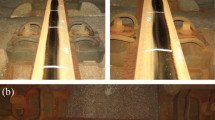Abstract
In this study, a semi-analytical pad model was developed to analyze the causes and mechanism of brake squeal of a rail pad in a railway brake system. A complex eigenvalue analysis was performed by developing the equation of motion of the contact area using a semi-analytical model. As a result, dynamic instability was indicated by the mode-merging of the z-translation mode and flexible mode of the rail pad. In addition, the z-translation mode of the rail pad has a large frequency change when increasing the contact stiffness, and mode-veering is generated by the surrounding flexible mode along the frequency loci. Therefore, z-translation mode is predicted to be major mode that generates the mode-coupling instability.
Similar content being viewed by others
References
G. X. Chen, Z. R. Zhou, P. Kapsa and L. Vincent, Experimental investigation into squeal under reciprocating sliding, Tribology International, 36(12) (2003) 961–971.
N. Fan and G. X. Chen, Numerical study of squeaking suppresses for ceramic-on-ceramic hip endoprosthesis, Tribology International, 48 (2012) 172–181.
B. C. Goo and J. C. Kim, Complex eigenvalue analysis of railway wheel/rail squeal, International Journal of Engineering Science and Technology, 8(1) (2016) 1–12.
H. Ouyang, W. Nack, Y. Yuan and F. Chen, Numerical analysis of automotive disc brake squeal: A review, International Journal of Vehicle Noise and Vibration, 1(3–4) (2005) 207–231.
F. Massi, G. Oliviero and L. Baillet, Brake squeal as dynamic instability: An experimental investigation, The Journal of the Acoustical Society of America, 120(3) (2006) 1388–1398.
J. Nam and J. Kang, Brake squeal analysis with respect to caliper contact stiffness, Transactions of the Korean Society for Noise and Vibration Engineering, 23(8) (2013) 717–724.
E. Denimal, S. Nacivet, L. Nechak and J. J. Sinou, On the influence of multiple contact conditions on brake squeal, Procedia Engineering, 199 (2017) 3260–3265.
C. Kim, Y. Kwon and D. Kim, Analysis of low-frequency squeal in automotive disc brake by optimizing groove and caliper shapes, International Journal of Precision Engineering and Manufacturing, 19(4) (2018) 505–512.
F. Cascetta, F. Caputo and A. D. Luca, Squeal frequency of a railway disc brake evaluation by FE analyses, Advances in Acoustics and Vibration (2018).
A. Belhocine and N. M. Ghazaly, Effects of Young’s modulus on disc brake squeal using finite element analysis, International Journal of Acoustics and Vibration, 21(3) (2016) 292–300.
Y. Du and Y. Wang, Squeal analysis of a modal-parameter-based rotating disc brake model, International Journal of Mechanical Sciences, 131 (2017) 1049–1060.
S. Nacivet and J. J. Sinou, Modal amplitude stability analysis and its application to brake squeal, Applied Acoustics, 116 (2017) 127–138.
J. Nam, H. Do and J. Kang, Investigation of friction induced vibration in lead screw system using FE model and its experimental validation, Applied Acoustics, 122 (2017) 98–106.
J. Nam, H. Choi and J. Kang, Finite element analysis for friction noise of simplified hip joint and its experimental validation, Journal of Mechanical Science and Technology, 30(8) (2016) 3453–3460.
J. Kang, Squeal analysis of gyroscopic disc brake system based on finite element method, International Journal of Mechanical Sciences, 51(4) (2009) 284–294.
J. Kang, Finite element algorithm reproducing hip squeak measured in experiment, Journal of Sound and Vibration, 393 (2017) 374–387.
J. Kang, Automotive brake squeal analysis with rotating finite elements of asymmetric disc in time, Journal of Sound and Vibration, 393 (2017) 388–400.
J. J. Sinou, A. Loyer, O. Chiello, G. Mogenier, X. Lorang, F. Cocheteux and S. Bellaj, A global strategy based on experiments and simulations for squeal prediction on industrial railway brakes, Journal of Sound and Vibration, 332(20) (2013) 5068–5085.
S. Hsu, Z. Huang, S. Iwnicki, D. Thompson, C. Jones, G. Xie and P. Allen, Experimental and theoretical investigation of railway wheel squeal, Proceedings of the Institution of Mechanical Engineers, Part F: Journal of Rail and Rapid Transit, 221(1) (2007) 59–73.
X. Liu and P. Meehan, Wheel squeal noise: A simplified model to simulate the effect of rolling speed and angle of attack, Journal of Sound and Vibration, 338 (2015) 184–198.
J. F. Brunel, P. Dufrénoy and F. Demilly, Modelling of squeal noise attenuation of ring damped wheels, Applied Acoustics, 65(5) (2004) 457–471.
S. De, Z. Rivera and D. Guida, Finite element analysis on squeal-noise in railway applications, FME Transactions, 46(1) (2018) 93–100.
J. Kang, C. M. Krousgrill and F. Sadeghi, Analytical formulation of mode-coupling instability in disc-pad coupled system, International Journal of Mechanical Sciences, 51(1) (2009) 52–63.
J. Kang, Squeal propensity due to rigid modes of brake pad, Proceedings of the Institution of Mechanical Engineers, Part C: Journal of Mechanical Engineering Science, 228(12) (2014) 2100–2109.
B. Goo, Analysis of unstable vibration modes due to KTX brake disc/pad interaction, Journal of the Korean Society for Railway, 16(4) (2013) 253–261.
J. Kang, Analytical approach for modal instability of a rigid brake pad, Proceedings of the Institution of Mechanical Engineers, Part D: Journal of Automobile Engineering, 229(6) (2015) 719–727.
J. Huang, C. M. Krousgrill and A. K. Bajaj, Modeling of automotive drum brakes for squeal and parameter sensitivity analysis, Journal of Sound and Vibration, 289(1–2) (2006) 245–263.
Author information
Authors and Affiliations
Corresponding author
Additional information
Recommended by Editor No-cheol Park
Jaeyoung Kang is a Professor in the Department of Mechanical Engineering, Inha University. He received his Ph.D. degree in Mechanical Engineering from Purdue University in 2008. His research interests include friction noise, structural vibration and nonlinear dynamics.
Rights and permissions
About this article
Cite this article
Nam, J., Kang, J. Semi-analytical approch for brake squeal of a rail pad. J Mech Sci Technol 34, 3147–3153 (2020). https://doi.org/10.1007/s12206-020-0706-2
Received:
Revised:
Accepted:
Published:
Issue Date:
DOI: https://doi.org/10.1007/s12206-020-0706-2




